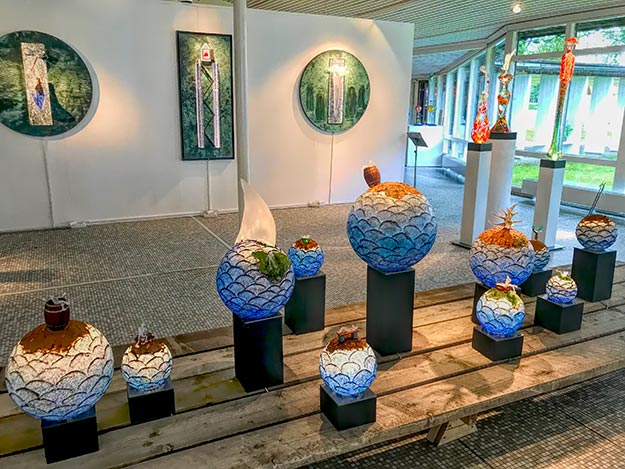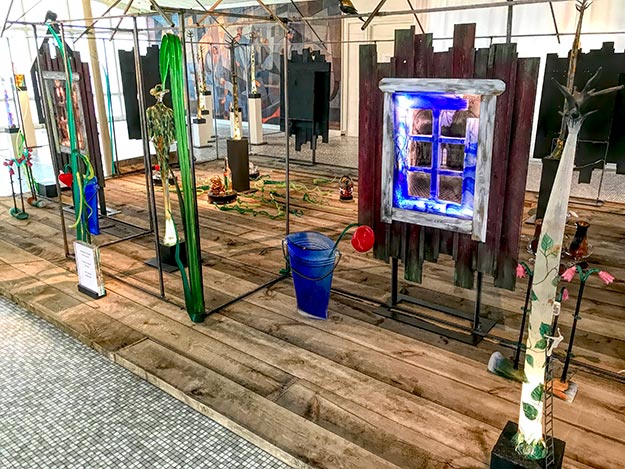From an early age, I was fascinated by the art of glassblowing. In those days, my exposure was limited to visiting tourist shops during family vacations, where glassblowers created a menagerie of crystal animals. I was transfixed each time an artist extracted a molten blob of glass from a blast furnace and fashioned it into a lifelike creature by forcing air through a blowpipe. To this day I have a box of those precious hand-blown glass animals, wrapped in tissue and stored in a safe place. My glass animal collection is one of the few things I couldn’t bear to part with when I sold my house to travel the world full time.

Glass blowing is an ancient art. Hand blown glass bottles have been found in excavations at a 2nd millennium B.C. Iranian archeological site. During the Roman Empire the art of glass-blowing achieved great popularity, eventually spreading throughout Europe, the Middle East, and into north Africa. By the 17th century, glass was being blown into shapes in many parts of the world. Still, most glass-blown pieces tended to be functional. That changed forever in 1962, when Harvey Littleton, a ceramics professor, and Dominick Labino, a chemist and engineer, burst onto the scene. During two workshops at the Toledo Museum of Art, they began experimenting with melting glass in a small furnace and creating three-dimensional glass sculptures. This “studio glass movement,” as it became known, launched glass blowing into the realm of fine art. Over time, the techniques were adopted by the likes of Tiffany and Steuben in the U.S., Hoya Crystal in Japan, and Kosta Boda Glassworks in Sweden.
My first introduction to this world of fine glass art came a few years ago when I visited the Hunter Museum of American Art in Chattanooga, Tennessee. In addition to a display of remarkable glass sculptures representing the studio art movement, the Hunter was also hosting a special exhibit of the works of Paul Stankard. Inside the darkened display space, scores of glass globes and slabs were illuminated by spot lighting. Miniature flowers, leaves, vines, bees, and butterflies were suspended within the glass. I blinked, not sure what I was seeing. How could flowers and insects survive being encased in molten hot glass? And then I picked up a brochure about the artist and learned that the scenes within the globes had also been wrought of glass. To this day I remain astonished by Stankard’s craftsmanship (view some of his extraordinary globes here).
When I learned that my Spectacular Scandinavia tour with Collette would include a visit to the Kosta Boda Glassworks in Sweden, I was almost beside myself with excitement. We began in the company’s showroom, where a representative explained the process of glass making. We learned about the raw materials needed to make fine crystal and how various colors of glass are created. Armed with this knowledge, we trooped across the courtyard to the factory, where artisans were making crystal wine glasses.
On one side of the work area, a worker used a long metal pipe to pull a glowing orange glob of molten glass out of the furnace. Using the attached pipe, she rolled the glass on a metal slab to produce the desired shape. The elongated glass cone was then dipped into a mold to flatten the bottom. Before the glass could cool, it was inserted into another mold and rotated rapidly. As it spun, the artisan blew air through the hollow pipe into the still molten material, forming the shape of a wine glass. Following the attachment of a stem, a separate blob of molten glass was dropped onto the bottom of the stem. Yet another artisan shaped the glowing blob into a flat, round base. It was mesmerizing to watch the team. They operated like a well-oiled machine. I was amazed that they did not bump into one another, given their small workspace.

I could have watched the highly synchronized team for hours, but the rest of Sweden beckoned. I made do with a quick tour of the museum portion of Kosta Boda Glassworks to view their collection of fine glass art, then did a mad dash through their outlet store before re-boarding the bus. It was just a couple of hours during a two-week tour of Scandinavia, but my visit to this famous glass factory will always be one of the highlights of my trip.
Author’s note: I was a guest of Collette during my Spectacular Scandinavia tour. However, the receipt and acceptance of complimentary items or services will never influence the content, topics, or posts in this blog. I write the truth, the whole truth, and nothing but the truth.

I enjoy reading and watching your blog…thanks for sharing….
This is so fabulous. I want to go to each of these museums. Inspiring. Thanks Barbara. And a tour with Collette also. Thanks for sharing all of this.
You’re very welcome June. I’m sure you’d enjoy traveling with Collette. They make everything so easy!
Barb,
This was a very interesting video. Thank you for sharing. It’s amazing how fast they work with such perfection.
Thanks Frances. Glad you enjoyed it. I was mesmerized by the way they worked with such precision.